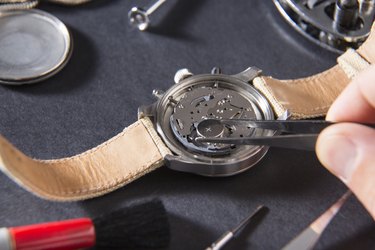
Batteries are essential to keeping your favorite devices powered. In recent years, lithium-ion has become the battery technology of choice for electronics such as laptops, PDAs and cellphones. A CR2032 battery and a CR2016 battery have similarities, but they're different in thickness and capacity, which means they aren't always interchangeable.
CR Series Batteries
Video of the Day
The most popular type of lithium-ion battery is a polycarbon monofluoride battery, which is designated as BR. The BR-type is the standard for small lithium-ion batteries, casually referred to as "button batteries" or "coin batteries" due to their small, round size. BR batteries are known for operating at high power from start to finish, while also being able to withstand hot temperatures.
Video of the Day
Another type of button battery, the CR battery, is a manganese dioxide lithium battery. CR batteries have a higher initial discharge than BR batteries, but taper off gradually as the battery ages. For that reason, you find BR batteries tend to be used for electronics such as cellphones and laptops, where consistent life is important. However, CR batteries are more affordable, making them popular for devices such as smoke detectors, bathroom scales, wristwatches and calculators.
Each CR battery is identified with four numbers, unique to that battery. Those four numbers refer to the thickness of the battery itself. When you're looking at CR2016 vs. CR2032, a CR2016 is 1.6 millimeters thick, and a CR2032 is 3.2 millimeters thick. The last two numbers on any CR battery tell you the thickness in millimeters.
CR2016 vs. CR2032 Interchangeability
The CR2016 and CR2032 may differ in thickness, but they're similar in many ways. They're both 3-volt models, and neither is rechargeable. However, it's important to note that they differ in capacity. CR 2032 has a 240 mAh capacity, while CR2016 is only 90 mAh. The CR2032 can provide 10 hours of use, while you only get about six hours from a CR2016, depending on the power you're drawing, of course.
Due to their identical voltage, there are some instances where you can interchange the CR2016 and CR2032. However, the fact that they have different capacities and, therefore, different runtimes can cause problems. You may not get the power from a CR2016 that you would from a CR2032, and some devices won't work at all.
Uses of Each CR Battery
When weighing CR2016 vs. CR2032, the biggest difference to you is likely where they're used. They both are similar in that they tend to be used in small devices, many of which are household items. You may not even realize an item uses a battery until it runs out, and you have to replace it.
Since the CR2016 battery has a shorter life span, you find it in items that don't draw much power, such as calculators and watches. A CR2016 battery can typically handle the low power draw on those items and offer months, if not years, of use. Items such as PC motherboards, car remotes, banking card readers and toys are built for CR2032 batteries.
Warnings About Button Batteries
The small size makes both the CR2032 and CR2016 batteries choking hazards. If you have small children in the house, make sure your button batteries stay safely stored out of their reach. Since these batteries are often found in toys, check the battery compartment of every toy your child plays with to confirm that it seals tightly.
If someone in your home ingests a button battery, seek help immediately. Choking is only one hazard. If left unchecked, a lithium-ion battery can become lethal in a matter of a couple of hours. Do not allow the person to eat or drink anything to avoid pushing it further down the esophagus.